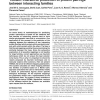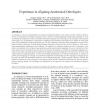55 search results - page 10 / 11 » Why Use a Unified Knowledge Representation |
WSC
2004
13 years 6 months ago
2004
Using simulated data to develop and study diagnostic tools for data analysis is very beneficial. The user can gain insight about what happens when assumptions are violated since t...
GECCO
2006
Springer
13 years 8 months ago
2006
Springer
A rectilinear Steiner arborescence (RSA) is a tree, whose nodes include a prescribed set of points, termed the vertices, in the first quadrant of the Cartesian plane, and whose tr...
NAR
2006
13 years 5 months ago
2006
An entire family of methodologies for predicting protein interactions is based on the observed fact that families of interacting proteins tend to have similar phylogenetic trees d...
SIGGRAPH
1999
ACM
13 years 9 months ago
1999
ACM
Traditionally, shape transformation using implicit functions is performed in two distinct steps: 1) creating two implicit functions, and 2) interpolating between these two functio...
IJSWIS
2007
13 years 4 months ago
2007
An ontology is a formal representation of a domain modeling the entities in the domain and their relations. When a domain is represented by multiple ontologies, there is need for ...


